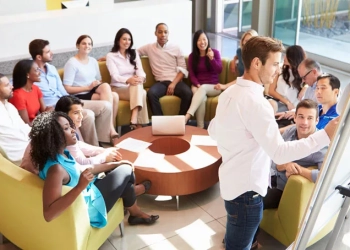Template 1: Team Goal Setting
Introduction: This template helps managers set clear and achievable team goals, ensuring alignment and focus.
Definition: Team goal setting defines a team’s specific objectives within a given timeframe.
Origins: The concept of goal setting originated from management theories such as SMART goals (Specific, Measurable, Achievable, Relevant, Time-bound), KPI’s, and OKRs (Objectives and Key Results).
Best Practices:
- Involve team members in the goal-setting process to foster ownership and commitment.
- Ensure goals are aligned with the organization’s overall objectives.
- Make goals specific, measurable, and time-bound to provide clarity and accountability.
- Regularly review and update goals to adapt to changing circumstances.
Features:
- Collaborative goal-setting process.
- Clear and measurable objectives.
- Regular progress tracking and updates.
Pros and Cons:
Pros:
- Enhances team alignment and focus.
- Increases motivation and productivity.
- Facilitates effective performance evaluation.
Cons:
- Goals may become rigid and limit creativity.
- Unrealistic goals can lead to demotivation.
Benefits:
- Improved team performance and productivity.
- Enhanced communication and collaboration.
- Increased employee engagement and satisfaction.
Example Steps:
- Gather the team and explain the purpose of goal setting.
- Discuss the organization’s objectives and how the team can contribute.
- Brainstorm specific goals that align with the team’s role and responsibilities.
- Evaluate each goal using the SMART criteria.
- Prioritize and finalize the goals.
- Break down each goal into actionable tasks and assign responsibilities.
- Set milestones and deadlines for tracking progress.
- Regularly review and update goals based on feedback and changing circumstances.
Template 2: Effective Communication
Introduction: This template focuses on establishing transparent and efficient communication channels within a team.
Definition: Effective communication is the process of exchanging information, ideas, and feedback in a manner that is easily understood and promotes collaboration.
Origins: Management experts and psychologists have studied and refined effective communication practices over the years.
Best Practices:
- Use multiple communication channels (e.g., meetings, emails, instant messaging) to cater to different needs.
- Be clear, concise, and specific in your messages.
- Encourage active listening and provide opportunities for team members to ask questions.
- Foster an open and inclusive communication culture.
- Provide regular feedback and recognition to promote continuous improvement.
Features:
- Clear and concise communication
- Active listening and feedback mechanisms
- Inclusive and open communication culture
Pros and Cons:
Pros:
- Facilitates better understanding and collaboration
- Reduces misunderstandings and conflicts
- Builds trust and rapport within the team
Cons:
- Overcommunication can lead to information overload
- Language and cultural barriers may hinder effective communication
Benefits:
- Improved teamwork and collaboration
- Enhanced problem-solving and decision-making
- Increased employee engagement and satisfaction
Example Steps:
- Establish preferred communication channels for different types of messages.
- Clearly define expectations for response times and availability.
- Encourage team members to ask questions and seek clarification.
- Provide regular updates and progress reports.
- Conduct team meetings to discuss important matters and address concerns.
- Foster a culture of open and honest communication.
- Implement feedback mechanisms to gather input from team members.
- Recognize and appreciate effective communication within the team.
(Note: The remaining templates will be provided in subsequent responses to ensure readability.)












![How To Deliver Leadership Skills Courses — Without Spending Weeks Designing Leadership Training Materials [Sale Now On]](https://www.oakinnovation.com/wp-content/uploads/2022/06/christopher-campbell-rDEOVtE7vOs-unsplash-1-scaled-jpg-350x250.webp)













































